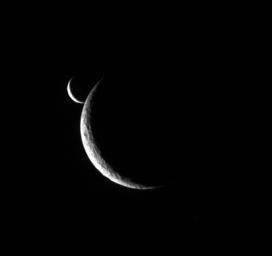
|
Rhea Releases Enceladus
- Click the image above for a larger view
- Full-Res JPEG (404 x 380) (3.8 kB)
- Full-Res TIFF (404 x 380) (153.9 kB)
Caption:
Two slim crescents smile toward the Cassini spacecraft following an occultation event.
Taken only five minutes after Enceladus (505 kilometers, or 314 miles across) first approached the limb of Rhea (1,528 kilometers, or 949 miles across), this view shows the bright little moon emerging from behind the larger moon's crescent. (See PIA08229 for the earlier view.)
The image was taken in visible light with the Cassini spacecraft narrow-angle camera on July 4, 2006 at a distance of approximately 1.4 million kilometers (800,000 miles) from Rhea and 1.9 million kilometers (1.2 million miles) from Enceladus. The view was obtained at a Sun-moon-spacecraft, or phase, angle of about 142 degrees relative to both moons. Image scale is 8 kilometers (5 miles) per pixel on Rhea and 11 kilometers (7 miles) on Enceladus.
Background Info:
The Cassini-Huygens mission is a cooperative project of NASA, the European Space Agency and the Italian Space Agency. The Jet Propulsion Laboratory, a division of the California Institute of Technology in Pasadena, manages the mission for NASA's Science Mission Directorate, Washington, D.C. The Cassini orbiter and its two onboard cameras were designed, developed and assembled at JPL. The imaging operations center is based at the Space Science Institute in Boulder, Colo.
For more information about the Cassini-Huygens mission visit http://saturn.jpl.nasa.gov/home/index.cfm . The Cassini imaging team homepage is at http://ciclops.org .
Cataloging Keywords:
| Name | Value | Additional Values |
|---|---|---|
| Target | Rhea | Enceladus |
| System | Saturn | |
| Target Type | Satellite | |
| Mission | Cassini-Huygens | |
| Instrument Host | Cassini Orbiter | |
| Host Type | Orbiter | |
| Instrument | Imaging Science Subsystem (ISS) | |
| Detector | Narrow Angle Camera | |
| Extra Keywords | Grayscale, Occultation, Visual | |
| Acquisition Date | ||
| Release Date | 2006-08-07 | |
| Date in Caption | 2006-07-04 | |
| Image Credit | NASA/JPL/Space Science Institute | |
| Source | photojournal.jpl.nasa.gov/catalog/PIA08237 | |
| Identifier | PIA08237 | |
